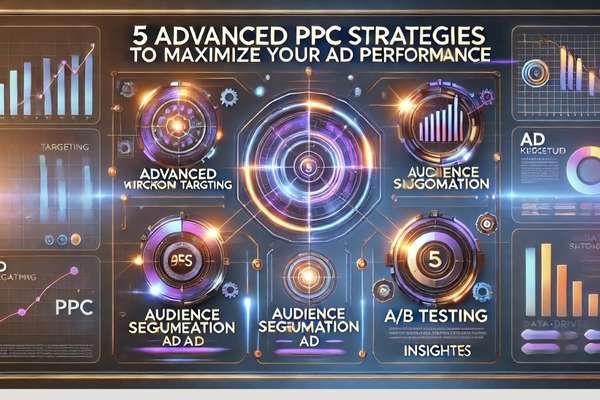
Understanding the Basics of Pay Per Click (PPC) Advertising
September 30, 2024
Maximizing Conversions with Social Media PPC Campaigns
September 30, 20245 Advanced PPC (Pay Per Click) Strategies to Maximize Your Ad Performance
Pay Per Click (PPC) advertising has become an essential part of every digital marketer’s toolkit. For those who want to maximize the performance of their campaigns, understanding advanced PPC strategies is crucial. In this article, we’ll explore five advanced strategies that can help boost your ad performance, targeting seasoned digital marketers, developers, and content creators. These techniques will give you a competitive edge in optimizing your PPC campaigns for better results.
Table of Contents
Chapter 1: Dynamic Keyword Insertion (DKI)
Dynamic Keyword Insertion (DKI) is an advanced PPC tactic that automatically updates your ad copy to include the search query typed by the user. This customization makes your ad more relevant to the searcher, improving your click-through rate (CTR) and Quality Score.
1.1 How DKI Works
Dynamic Keyword Insertion modifies your ad’s headline or body text to include the exact keyword searched by the user. For example, if you’re bidding on the keyword “best PPC software,” and the user types in “top PPC software,” your ad will dynamically update to match their query.
Benefits of DKI:
- Increases relevance: The user sees exactly what they searched for, improving the likelihood of engagement.
- Enhances CTR: Studies show that ads using DKI often see a higher CTR due to their targeted nature.
- Improves Quality Score: Higher relevancy leads to improved Quality Scores, which lowers your cost-per-click (CPC).
Pro Tip: While DKI is effective, be cautious not to allow irrelevant or grammatically awkward keywords into your ad copy. Use negative keywords and closely monitor your campaigns.
Chapter 2: Advanced Audience Targeting with Remarketing Lists for Search Ads (RLSA)
Remarketing Lists for Search Ads (RLSA) allows you to customize your search ads for people who have already visited your website. By tailoring ads based on past user behavior, RLSA helps increase conversions and reduce wasted ad spend.
2.1 Setting Up RLSA
With RLSA, you can segment users based on their previous interactions with your site, such as viewing a specific product or adding an item to their cart but not purchasing. You can bid more aggressively for high-intent visitors and show them ads with personalized offers.
How RLSA Enhances Performance:
- Precision targeting: Focus on users who are already familiar with your brand, improving the likelihood of conversion.
- Custom bidding: Adjust your bids based on the user’s past behavior on your website, ensuring you don’t overspend on low-intent visitors.
- Personalized ads: Display customized ad messages that appeal to returning visitors, such as special offers or reminders.
Pro Tip: Combine RLSA with broad match keywords to target users who may search for related terms on their return visits. This opens opportunities for additional conversion paths.
Chapter 3: Leveraging Ad Extensions for Maximum Ad Space
Ad extensions are an advanced PPC feature that can significantly enhance your ads by providing additional information and making them more prominent on the search engine results page (SERP). Google Ads offers various types of extensions, including sitelinks, callouts, and structured snippets.
3.1 Types of Ad Extensions
Each extension serves a specific purpose, from displaying extra links to adding contact information. Here’s a breakdown of some common ad extensions and their benefits:
- Sitelink extensions: Add multiple links to specific pages of your site, increasing the chances of engagement. For example, if you’re advertising PPC software, you can direct users to pages for pricing, features, or testimonials.
- Callout extensions: Highlight unique selling points or promotions such as “Free Trial” or “24/7 Support.”
- Structured snippet extensions: Display a predefined list of services or products, which helps clarify what you offer without cluttering the ad text.
3.2 Why Use Ad Extensions?
Ad extensions not only provide more information to potential customers but also increase the size of your ad, making it more noticeable. Studies show that ads with extensions have higher CTRs than those without them.
Pro Tip: Ensure that your extensions are relevant to your audience. For example, a developer-oriented audience may appreciate callout extensions highlighting “API Integrations” or “Custom Solutions.”
Chapter 4: Bid Adjustments for Mobile, Location, and Time
Advanced PPC campaigns require a nuanced approach to bidding. Bid adjustments allow you to raise or lower your bids based on factors such as device type, location, and time of day. By optimizing your bids for different scenarios, you can improve your return on ad spend (ROAS).
4.1 Mobile Bid Adjustments
With the rise of mobile search, optimizing bids for mobile devices is crucial. If your website or landing page is mobile-friendly, consider increasing your bid adjustments for mobile users to capture more traffic. Alternatively, if you don’t have a mobile-optimized site, lower your bids to avoid poor user experiences.
How to Apply Mobile Bid Adjustments:
- Analyze performance data: Review your mobile traffic and conversion rates to determine if mobile bid adjustments are necessary.
- Optimize for high-converting devices: If mobile traffic consistently converts better, raise your bids on mobile to capitalize on that behavior.
4.2 Location-Based Bid Adjustments
Location-based adjustments allow you to bid more aggressively in high-performing regions. For instance, if your PPC campaigns perform particularly well in the U.S. but not as well in Canada, you can increase bids in the U.S. and reduce bids in Canada to optimize your budget.
4.3 Time-of-Day Bid Adjustments
Not all hours of the day are equal in PPC. Analyze your ad performance based on time of day to identify peak hours for conversions. Adjust your bids accordingly to capitalize on high-converting times, while scaling back during off-peak periods.
Pro Tip: Use Google Analytics to track when users are most likely to engage with your content. Cross-reference this data with your ad performance reports for optimal bid adjustments.
Chapter 5: Conversion Rate Optimization (CRO) for PPC Landing Pages
One of the most overlooked yet critical aspects of PPC success is conversion rate optimization (CRO) for landing pages. You can drive endless traffic to your site, but if the landing page isn’t optimized for conversions, you’ll waste ad spend.
5.1 Design Elements for High-Performing Landing Pages
A well-optimized landing page should be fast, mobile-friendly, and feature a clean design that aligns with the ad’s messaging. The page should also include a clear and compelling CTA (Call-to-Action), whether it’s to sign up for a newsletter, download an eBook, or purchase a product.
Important CRO Tactics for PPC:
- A/B Testing: Continuously test different elements of your landing page, including headlines, CTAs, and form placements, to find the highest-converting version.
- Minimize distractions: Keep the focus on the primary goal, whether that’s filling out a form or making a purchase. Avoid unnecessary links or navigation bars.
- Fast load times: Google prioritizes fast-loading pages, and slow load times can negatively impact your Quality Score and conversion rates. Use tools like GTmetrix to analyze and improve page load speed.
5.2 Aligning Ad Copy with Landing Page Content
Consistency between your ad copy and landing page is vital for improving conversion rates. If your ad promises a “50% off PPC software deal,” ensure the landing page prominently features this offer. Misaligned messages can lead to high bounce rates and wasted clicks.
Pro Tip: Use Unbounce or Instapage to create dedicated landing pages that are specifically designed for PPC campaigns. These tools allow for easy A/B testing and can significantly improve your CRO.
5 Advanced PPC (Pay Per Click) Strategies to Maximize Your Ad Performance Recap
| Tool/Strategy | Best For | Key Features | External Link |
|---|---|---|---|
| Google Keyword Planner | Keyword Research | Estimate CPC, find long-tail keywords | Visit Site |
| Google Ads Smart Bidding | Automated Bidding | Maximize conversions using AI | Visit Site |
| SEMrush | Competitor Analysis | Track keyword costs and competitors | Visit Site |
| Facebook Ads Manager | Diversified Platforms | Run PPC campaigns on Facebook/Instagram | Visit Site |
| Google Analytics | Performance Monitoring | Track conversion rates, audience insights | Visit Site |
Frequently Asked Questions
1. How can I reduce my PPC costs while maintaining performance?
To reduce your PPC costs, focus on improving your Quality Score. A higher Quality Score leads to lower cost-per-click (CPC). You can also refine your keyword list, use negative keywords to avoid irrelevant clicks, and set appropriate bid adjustments based on device, location, and time.
2. What is the most important metric to track in PPC?
The most important metric in PPC depends on your business goals, but conversion rate and ROAS (Return on Ad Spend) are crucial for measuring campaign success. CTR and Quality Score are also important metrics to monitor for improving ad performance.
3. Can I run a successful PPC campaign on a small budget?
Yes, even small businesses can run effective PPC campaigns by targeting long-tail keywords with lower competition and bidding carefully based on performance data. Scaling gradually, optimizing Quality Score, and using negative keywords can also help maximize a smaller budget.
Conclusion
Advanced PPC strategies, such as Dynamic Keyword Insertion, RLSA, and CRO for landing pages, offer digital marketers, developers, and content creators powerful tools to enhance ad performance. By optimizing audience targeting, refining bid adjustments, and leveraging ad extensions, you can take your PPC campaigns to the next level. Stay proactive with A/B testing and continuous data analysis to ensure long-term success in your campaigns.








